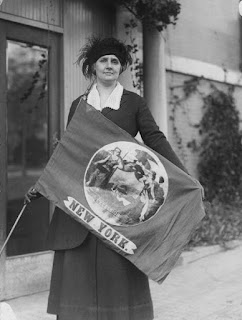November 14, 1917: The Night of Terror
“Never would I recover
from this wound, this ugly knowledge I had gained of what men were capable in
their treatment of each other. It was
one thing to be writing about these things, to have the theoretical knowledge
of sweatshops and injustice and hunger, but it was quite another to experience
it in one’s own flesh.” --Dorothy
Day, one of the Silent Sentinels brutalized during the Night of Terror.
Nina Allender's illustration from The Suffragist Newspaper,
November 1917
One hundred and two years ago, 33 women were sent to the Occoquan
Workhouse. They had been charged with
obstructing traffic but the real crime was that they were protesting peacefully
outside The White House.
Since January,
a steady stream of women had been picketing the White House. At first they were a novelty to
Washingtonians, even featured on tourist tours.
January 1917
But after the United States entered World War 1, the “Silent Sentinels” were perceived as unpatriotic. They were clearly an embarrassment to Woodrow
Wilson. By summer they were being
arrested for picketing and often sent to Occoquan Workhouse.
Deprived of their natural rights—including the right to see
their lawyer, mail correspondence, or buy anything for themselves in the
prison store, the women considered themselves political prisoners. By November 14, 1917 the press was
already speculating about the health of Alice Paul who had been arrested in October
and was on a hunger strike with Rose Winslow and who would soon be joined by
Kate Heffelfinger.
The women were made to wait in the warden’s office and not
immediately processed into their cells. When the Superintendant Whittaker (the warden) did come in, he brought along
a group of thugs who beat and tortured the women; all accounts that I read
stated Superintendant Whittaker directed the whole attack.
All of the women were sent to the men’s prisons where they had no privacy available to them. But the beatings and the torture were even worse.
All of the women were sent to the men’s prisons where they had no privacy available to them. But the beatings and the torture were even worse.
Another illustration by Nina Allender
“I saw Dorothy Day brought in. She is a frail girl. The two men handling her were twisting her
arms above her head. Then suddenly they
lifted her up and banged her down over the arm of an iron bench—twice. As they ran past me, she was lying there with
her arms out, and we heard one of the men yell “The----suffrager! My mother ain’t no suffrager. I’ll put you through ----" reported Mrs. Mary Nolan the oldest
suffragist of the group at age 73.
Dorothy Day in 1916, she would later co-found the Catholic Worker Movement
Mary Nolan
Once in her room, Mrs. Nolan reported that “Mrs. (Dora) Lewis,
doubled over and handled like a sack of something, was literally thrown
in. Her head struck the iron bed. We thought she was dead. She didn’t move.” Alice Cosu who was also in the cell was so upset that she had a
heart attack and was denied medical assistance.
Dora Lewis upon her release from prison
Lucy Burns, the co-founder of the National Woman’s Party was
shackled with her arms above her for calling a roll call to see if all the
women were present or if something worse had happened to them. She was also threatened with a straightjacket
and gag.
Lucy Burns
When a male doctor did come to see the women later, the
women asked for a female doctor and refused to undress in front of him. Per Lucy Burn’s notes, they “were dragged
through halls by force, our clothing removed by force and we were examined…”
Most of the women went on hunger strikes. You can read about the Night of Terror all
over the internet. I wanted you to hear first-hand
accounts from the book , Jailed For
Freedom written by Doris Stevens and
published in 1920. It’s free to read on
google books.
But here’s the thing—the women never gave in. And many of them went right back to the
picket line once they were released. The
absolute tenacity of these women was commented on by a government doctor at the
workhouse:
Thank you Silent Sentinels.
You are not forgotten.









Michele, I learned about your blog this week through our mutual friend Janet. I very much enjoy your posts.
ReplyDelete